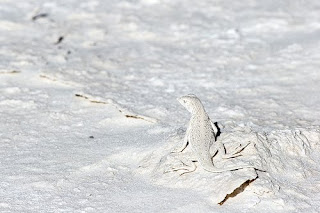...that's the question that pops into my mind after reading the title and abstract. I wonder if they genotyped the elite of the elite (Bolt, Powell) or just the "elite"? It looks like they did:
Given these results, Usain probably does lack the ACTN3 polymorphism, but on the other hand, he could be the one of the two out of the 46 elite-elite sprinters who is homozygous for it.
P.S. - gotta love the senior author's name!
ACTN3 and ACE Genotypes in Elite Jamaican and US SprintersForty-six of these international athletes had won medals at major international competition or held sprint world records.Nevertheless, another negative finding on the association between the ACTN3 fast twitch muscle fiber, "sprint" genotype and sprint phenotypes. In fact, two of the elite-elite Jamaican sprinters were homozygous for the slow-twitch variant! They acknowledge that the power to detect a difference here is pretty low because of the very low frequency of the ACTN3 R5777X polymorphism in West Africans... so much for personalized prediction of sports ability, at least for now. I say just look at your big toe... does it extend out farther than your second toe? if so, you could probably be pretty fast.
Given these results, Usain probably does lack the ACTN3 polymorphism, but on the other hand, he could be the one of the two out of the 46 elite-elite sprinters who is homozygous for it.
P.S. - gotta love the senior author's name!
SCOTT, ROBERT A; IRVING, RACHAEL; IRWIN, LAURA; MORRISON, ERROL; CHARLTON, VILMA; AUSTIN, KRISTA; TLADI, DAWN; DEASON, MICHAEL; HEADLEY, SAMUEL A.; KOLKHORST, FRED W.; YANG, NAN; NORTH, KATHRYN; PITSILADIS, YANNIS P.
ABSTRACT The angiotensin-converting enzyme (ACE) and the [alpha]-actinin-3 (ACTN3) genes are two of the most studied "performance genes" and both have been associated with sprint/power phenotypes and elite performance. Purpose: To investigate the association between the ACE and the ACTN3 genotypes and sprint athlete status in elite Jamaican and US African American sprinters. Methods: The ACTN3 R577X and the ACE I/D and A22982G (rs4363) genotype distributions of elite Jamaican (J-A; N = 116) and US sprinters (US-A; N = 114) were compared with controls from the Jamaican (J-C; N = 311) and US African American (US-C; N = 191) populations. Frequency differences between groups were assessed by exact test. Results: For ACTN3, the XX genotype was found to be at very low frequency in both athlete and control cohorts (J-C = 2%, J-A = 3%, US-C = 4%, US-A = 2%). Athletes did not differ from controls in ACTN3 genotype distribution (J, P = 0.87; US, P = 0.58). Similarly, neither US nor Jamaican athletes differed from controls in genotype at ACE I/D (J, P = 0.44; US, P = 0.37). Jamaican athletes did not differ from controls for A22982G genotype (P = 0.28), although US sprinters did (P = 0.029), displaying an excess of heterozygotes relative to controls but no excess of GG homozygotes (US-C = 22%, US-A = 18%). Conclusions: Given that ACTN3 XX genotype is negatively associated with elite sprint athlete status, the underlying low frequency in these populations eliminates the possibility of replicating this association in Jamaican and US African American sprinters. The finding of no excess in ACE DD or GG genotypes in elite sprint athletes relative to controls suggests that ACE genotype is not a determinant of elite sprint athlete status.


